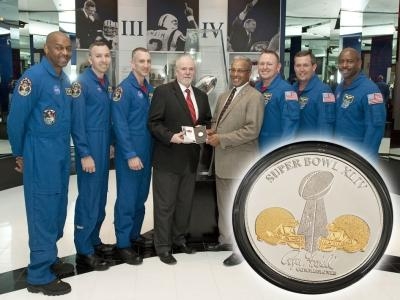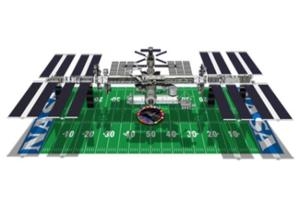Space Technology Has A Major Role With The NFL, Super Bowl
When mission managers yell, “Touchdown!” chances are that they are celebrating the arrival of a spacecraft on a planetary surface. When National Football League players yell it, it means something completely different. But did you know that NASA also has made a few plays on the football field? When it comes to protecting athletes and outreach, the space agency does not sit on the sidelines.

In the 1960s, scientists at NASA Ames Research Center in California huddled together to test a shock-absorbing polyurethane plastic foam called Temper Foam. Commonly known as memory foam, it takes the shape of an object after having been compressed and returns to its original shape. Today, the inside of a football helmet is lined with this kind of foam, providing players with more protection. The exterior shells of many helmets are made with a material called Lexan. Although it was developed by a German scientist in 1953, NASA researchers tested it and discovered that the light substance was resilient enough to stop a bullet, a micrometeoroid, or in the NFL’s case, a defensive tackle. Thus, it was put to use in padding and helmets.
Newly-retired astronaut Leland Melvin has firsthand experience with these materials. The two-time Shuttle veteran (STS-122 and STS-129) was drafted into the NFL by the Detroit Lions in 1986. He also spent time with the Dallas Cowboys until a pulled hamstring halted his football career.
The opening-toss coin used in 2010’s Super Bowl XLV had a long trip to Cowboys (now AT&T) Stadium. This silver medallion had flown in space aboard STS-129 Atlantis, logging a total of four million miles in 171 orbits around Earth. The coin, along with other signed memorabilia flown in space, was presented to the Pro Football Hall of Fame in Canton, Ohio, on January 27, 2010.
One year later, NASA’s next-generation humanoid robot, Robonaut 2, made its primetime debut during Super Bowl XLVI. A General Motors commercial showcased the robot’s capability of working side-by-side with humans. Robonaut 2 could one day be used to take over simple tasks that may pose a risk to astronauts. Currently, NASA and General Motors are developing climbing legs for the robot that would allow it to move outside the Space Station, but don’t expect it to punt a football anytime soon.

This year, Super Bowl XLVII will be broadcast in 185 countries, but that would not have been possible without the aid of NASA-developed communication satellites. When the experimental Telstar satellite was launched in 1962, a new era of television broadcasting was born. People in Europe were able to watch parts of a news conference with President Kennedy for the first time. Today, audiences abroad can watch fumbles and interceptions along with those of us in the United States.
Coaches didn’t always have lightweight wireless headsets like they do today. After the Liberty Bell 7 capsule splashed down in 1961 and flooded the cabin, ceasing all communications between Gus Grissom and his recovery team, NASA contacted Pacific Plantronics (now Plantronics, Inc.) to jointly develop a way to implant the MS-50 headsets (developed by ITT Labs in Fort Wayne, Ind.) inside an astronaut’s helmet. In 1962, astronaut Wally Schirra was the first to use the new headset, which included a noise-cancelling feature, on the Mercury-Atlas 8 mission. The same technology, albeit improved in the years to follow, was used throughout Gemini and Apollo, and Skylab. Today, NFL coaches use the technology to communicate with one another along the sidelines.
NASA Spinoff technology has played a crucial role in the NFL. Perhaps it is not a coincidence that the International Space Station is the length of a football field (including the end zones).
(Pictured: Top: The crew of STS-129 present the opening toss coin, which was flown aboard the mission, to NFL officials. Bottom: ISS is about the size of a football field)
 SpaceX to Launch Inversion RAY Reentry Vehicle in Fall
SpaceX to Launch Inversion RAY Reentry Vehicle in Fall Aero-News: Quote of the Day (04.23.24)
Aero-News: Quote of the Day (04.23.24) Aero-News: Quote of the Day (04.20.24)
Aero-News: Quote of the Day (04.20.24) ANN's Daily Aero-Linx (04.20.24)
ANN's Daily Aero-Linx (04.20.24) Aero-News: Quote of the Day (04.21.24)
Aero-News: Quote of the Day (04.21.24)




